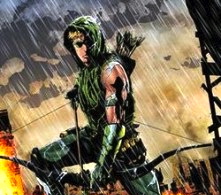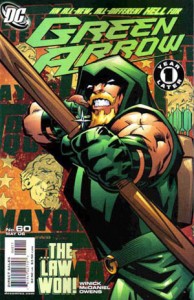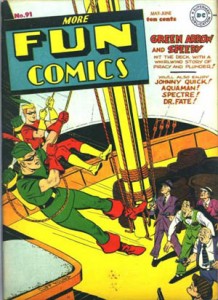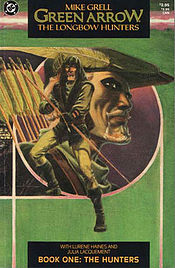Green Arrow

Green Arrow
Green Arrow protects a young princess from assassins while waiting for Black Canary at the airport.
 Green Arrow (Modern Version), Cover to Green Arrow (vol. 6) #17 (February 2013). Art by Andrea Sorrentino.
Green Arrow (Modern Version), Cover to Green Arrow (vol. 6) #17 (February 2013). Art by Andrea Sorrentino.
Green Arrow is a fictional character, a superhero that appears in comic books published by DC Comics. Created by Morton Weisinger and designed by George Papp, he first appeared in More Fun Comics #73 in November 1941. His real nameis Oliver Queen, a billionaire businessman and owner of Queen Industries, as well as a well-known celebrity in his locale of Star City. Sometimes shown dressed like Robin Hood, Green Arrow is an archer who invents trick arrows with various special functions, such as glue arrows, diversions (smoke), net, explosive, time bomb, grappling, fire extinguishing, flash, boomerang, and tear gas arrows, as well as cryonic arrows, and even a kryptonite arrow. At the time of his debut, Green Arrow functioned in many ways as an archery-themed analogue of the very popular Batman character, but the writers at DC subsequently developed him into a voice of left wing and progressive politics very much distinct in character from Batman, with his own supporting cast.
Throughout his first twenty five years, Green Arrow wasn’t a significant hero. In the late 1960s, writer Denny O’Neil, inspired by the character’s dramatic visual redesign by Neal Adams, chose to have him lose his fortune, giving him the then-unique role of a streetwise crusader for the working class and the disadvantaged. In 1970, he was paired with a more law and order-oriented hero, Green Lantern, in a ground-breaking, socially conscious comic book series. Since then, he has been popular among comic book fans and most writers have taken an urban, gritty approach to the character. The character was killed off in the 1990s and replaced by a new character, Oliver’s son Connor Hawke, the second Green Arrow; however, Hawke proved a less popular character, and the original Oliver Queen character was resurrected in the 2001 “Quiver” storyline, by writer Kevin Smith. In the 2000s, the character has been featured in bigger storylines focusing on Green Arrow and Black Canary, such as the DC event The Green Arrow/Black Canary Wedding and the high-profile Justice League: Cry for Justice storyline, prior to the character’s relaunch alongside most of DC’s properties in 2011.
 Cover to Green Arrow (vol. 3) #60 (May 2006). Art by Scott McDaniel.
Cover to Green Arrow (vol. 3) #60 (May 2006). Art by Scott McDaniel.
Green Arrow wasn’t initially a well-known character outside of comic book fandom; he had appeared in a single episode of the animated series Super Friends in 1973. In the 2000s, the character featured in a number of DC television properties, including the animated series Justice League Unlimited, Young Justice, The Batman and Batman: The Brave and the Bold, several DC Universe Animated Original Movies and the live action series Smallville, played by actor Justin Hartley, who became a core cast member. In 2012-2013, the live action seriesArrow debuted on The CW, in which the title character is portrayed by Stephen Amell.
Publication history – Beginnings, 1941–1968
 More Fun Comics #91 (May/June 1943). Green Arrow’s original costume. Art by Cliff Young.
More Fun Comics #91 (May/June 1943). Green Arrow’s original costume. Art by Cliff Young.
Green Arrow and Speedy first appeared in More Fun Comics #73 (cover-dated November 1941), which was illustrated by artist George Papp. When Mort Weisinger was creating the character, aside from the obvious allusions to Robin Hood, he took inspiration from a movie serial, The Green Archer, based on the novel by Edgar Wallace. He retooled the concept into a superhero archer with obvious Batman influences. These include Green Arrow’s sidekick Speedy, his use of an Arrow-Car and Arrow-Plane for transportation, his use of an Arrow-Cave as his headquarters, his alter ego as a billionaire playboy, the use of an Arrow-Signal to summon him, and a clown-like arch foe named Bull’s Eye, similar to Batman’s arch-foe, the Joker.
Another Weisinger-created character, Aquaman, also appeared for the first time in that issue, and these two back-up features continued to run concurrently in More Fun Comics until the mid-1940s, and then in Adventure Comics between 1946 and 1960. Green Arrow and Speedy also appeared in various issues of World’s Finest Comics until issue #140 (1964). The Green Arrow and Speedy feature was one of five back-up features to be promoted in one of the earliest team-up books, Leading Comics.
Green Arrow was one of the few DC characters to keep going after the Golden Age of Comic Books. The longevity of the character was due to the influence of creator Mort Weisinger, who kept Green Arrow and Aquaman as back-up features to the headlining Superboy feature, first in More Fun Comics and then Adventure Comics. Aside from sharing Adventure Comics with him, issue #258 featured an encounter between a younger Oliver Queen and Superboy. The Green Arrow and Speedy feature during this period included a short run in 1958 written by Dick and Dave Wood and drawn by Jack Kirby. For much of this period, Green Arrow’s adventures were written by France Herron, who was the character’s primary scripter from 1947–1963.
Neal Adams and Dennis O’Neil, 1969–1983
In 1969, artist Neal Adams decided to update the character’s visual appearance by giving him a goatee and costume of his own design in The Brave and the Bold #85 (August–September 1969). Inspired by Adams’s redesign, writer Dennis O’Neil followed up on Green Arrow’s new appearance by completely remaking the character’s attitude in the pages of Justice League of America #75 (cover-dated November 1969), giving his personality a rougher edge. This revision was explained by having Oliver Queen lose his fortune due to forged documents of him engaging in corruption, and he then became an outspoken advocate of the underprivileged in society and the political left wing. For instance, he once saved a child’s dog playing in a railyard, but instead of feeling satisfaction, he brooded on the larger problem of how the child had nowhere in the city to play safely.
 Green Lantern (vol. 2) #76 (April 1970). Cover art by Neal Adams.
Green Lantern (vol. 2) #76 (April 1970). Cover art by Neal Adams.
In the early 1970s, Green Arrow became a co-feature with Green Lantern (Hal Jordan) in the latter’s series in an acclaimed, but short-lived, series of stories by O’Neil and Adams that dealt with various social and political issues in which Green Arrow spoke for radical change while Green Lantern was an establishment liberal figure, wanting to work within existing institutions of government and law. Where Queen advocated direct action, Hal Jordan wanted to work within the system; where Queen advocated social change, Jordan was more concerned about dealing with criminals. Each would find their beliefs challenged by the other. Queen convinced Jordan to see beyond his strict obedience to the Green Lantern Corps, to help those who were neglected or discriminated against. As O’Neil explained: “He would be a hot-tempered anarchist to contrast with the cerebral, sedate model citizen who was Green Lantern.” The duo embarked on a quest in a beat-up pickup to find America, along the way witnessing the problems of corruption, racism, pollution, and overpopulation confronting the nation. Writer O’Neil even took on current events, such as the Manson Family cult murders, in issues #78–79 (“A Kind of Loving”) where the Black Canary falls briefly under the spell of a false prophet who advocates violence.
It was during this period that the most famous Green Arrow story appeared, inGreen Lantern (vol. 2) #85–86, when it was revealed that Green Arrow’s ward, Speedy, was addicted to heroin. In his zeal to save America, Oliver had failed in his personal responsibility to Speedy – who would overcome his addiction with the help of the Black Canary, Green Arrow’s then-love interest. This story prompted a congratulatory letter from the mayor of New York, John Lindsay. Unfortunately, the series did not match commercial expectations, and Neal Adams had trouble with deadlines, causing issue #88 to be an unscheduled reprint issue; the series was canceled with issue #89 (April/May 1972).
The duo were moved to the back-up feature in The Flash, issues #217 through #219. The socially relevant themes would continue, as the story opens with Oliver killing a criminal (albeit accidentally). Oliver shed himself of the remaining trappings of his super-heroic life (including crashing the Arrow-Plane into a mountain) and withdrew to an ashram monastery. He would find no peace there, and he returned to the outside world at the request of Hal and Dinah. This storyline would prove very important to the character in the 1990s. After this three-part story, Green Lantern continued as a solo back-up in The Flash, while Green Arrow’s solo stories began appearing in Action Comics.
In 1976, the Green Lantern title was re-launched starring both Hal Jordan and Ollie Queen, and the Green Arrow/Green Lantern partnership returned to more traditional superhero storylines. Denny O’Neill resumed writing the characters, while Adams-influenced artist Mike Grell drew the feature. After the title moved to solo Green Lantern stories, solo Green Arrow stories began appearing in the World’s Finest title. The solo stories were frequently written by Elliot S. Maggin.
In his solo series, Oliver would land a job as a newspaper columnist, which allowed him to articulate his political beliefs in a more public field. In World’s Finest #255 (1979), Queen ran for Mayor of Star City and lost in a close vote. Although there was reason to believe that the election had been fixed against him, the Black Canary chose for him not to contest the results legally, effectively ceding the race to his opponent.
In May through August 1983, Green Arrow appeared for the first time in his own comic book, a four issue limited series of murder and betrayal that established potential for a full series. It was in this miniseries that Green Arrow would gain a running rivalry with the super villain Count Vertigo.
In 1985, a Green Arrow died in the Crisis on Infinite Earths, wearing red boots and gloves, suggesting this was a leftover Earth-2 character being disposed of, especially considering no resurrection was later acknowledged before his further appearances.
Mike Grell Ongoing – Green Arrow: The Longbow Hunters
 Green Arrow: The Longbow Hunters #1, the gritty redefinition of Green Arrow. Cover by Mike Grell.
Green Arrow: The Longbow Hunters #1, the gritty redefinition of Green Arrow. Cover by Mike Grell.
In 1987, DC Comics launched the character into a new ongoing title as part of their mature audience comic line. Written and illustrated by Mike Grell, the revamp was launched with Green Arrow: The Longbow Hunters mini-series. In this three-issue prestige format limited series, a routine adventure against a group of drug runners led to tragedy as the Black Canary was captured and brutally tortured. In response, Oliver murders his girlfriend’s attackers. The mini-series would also introduce the enigmatic female Japanese archer, Shado, whose family had suffered in a World War II internment camp.
Under Grell, Green Arrow would abandon the use of his trademark gadget arrows and relocate from Star City to Seattle, Washington. As the series was part of DC Comics’ mature audience line, it took on a more gritty, violent, and urban tone, with Green Arrow often using deadly force against his enemies. Grell wrote the series for the first 80 issues, downplaying the super-hero aspects of the characters; Oliver abandoned his mask and was never actually referred to as “Green Arrow”, and Black Canary was never shown using her sonic scream power. (Sometimes, this was explained as having lost it due to the events of The Longbow Hunters, though this was not consistent with her appearances in other titles published during this period). While crossover specials were conceived to allow other writers (most notably Denny O’Neil, who wrote “Batman” and the mature audience comic The Question) to use Green Arrow, Grell wrote him as largely isolated from the rest of the DC Universe; when other DC characters like longtime friend Hal Jordan (a.k.a. Green Lantern) appeared, they did so in street clothes and used only their civilian names.
In place of the super-hero community, Grell created his own supporting cast. In addition to Shado, Grell introduced Seattle police Lieutenant Jim Cameron, who was disgusted with Green Arrow’s vigilante actions (including killing criminals); renegade CIA agent Greg Osborne, who began to monitor Queen’s activities; and mercenary Eddie Fyers, initially introduced as Queen’s adversary, but later to become a companion of necessity when Green Arrow was forced to leave Seattle after false accusations of aiding terrorists. Grell’s run ended with Green Arrow #80, shortly after Dinah dumped Oliver.
During this period, the writer also redefined the character’s origin in the four-part 1992 limited series, Green Arrow: The Wonder Year. Grell portrayed Oliver Queen as a thrill-seeker who inherits his family business at a very young age. Changed by his sojourn on the island, Oliver decided to take up crime fighting as a means of rebelling against his responsibilities. During his first adventure in Star City, Oliver Queen meets an old flame, Brianna Stone, a former college radical who warns him if he continued to carry his bow, he would one day have to use it for real. Grell’s limited series also established Queen’s attraction toward dangerous women.
Post-Grell
Once Grell left the series, DC almost immediately began restoring Green Arrow to the mainstream DC Universe. His ongoing series (mostly written by Kelley Puckett and drawn by artist Jim Aparo) was removed from the “Mature Audience” line (which had evolved into “Vertigo“) with #63, prior to Grell’s departure, and Green Arrow began appearing in various super-hero titles as a guest, most notably Green Lantern #47, which had Oliver aiding Green Lantern in rescuing his longtime girlfriend Carol Ferris and her family from one of Hal’s enemies, and the 1994 DC Comics mini-series Zero Hour. In Zero Hour, Queen is forced to shoot his old friend at a pivotal moment. Now tightly integrated in the DC Universe, the character Connor Hawke was introduced and revealed as Oliver Queen’s son.
 Connor Hawke and Oliver Queen on the cover to Green Arrow Secret Files & Origins #1 (December 2002). Art by Matt Wagner.
Connor Hawke and Oliver Queen on the cover to Green Arrow Secret Files & Origins #1 (December 2002). Art by Matt Wagner.
In Green Arrow #100–101, Oliver would infiltrate a group of eco-terrorists known as the Eden Corps and sacrifice his life in order to prevent the group from detonating a bomb that would destroy the city of Metropolis, the resulting explosion completely atomising Queen’s body so that his identity could only be confirmed by Superman witnessing his death. This allowed the writers to shake up the status quo by making Connor Hawke a replacement Green Arrow. The series, now written by Chuck Dixon, would continue, with Hawke as the main focus until issue #137, when the series was canceled.
Smith, Hester and Parks/Meltzer 2000–2004 – Quiver (comics)
 Promotional for Green Arrow(vol. 3) #1 cover. Art by Matt Wagner.
Promotional for Green Arrow(vol. 3) #1 cover. Art by Matt Wagner.
In 2000, Oliver Queen is revived in a new series, Green Arrow (vol. 3), in the story arc “Quiver,” written by Kevin Smith and illustrated by Phil Hester and Ande Parks. It is revealed that Hal’s resurrection of Oliver (seen on the very last page of Green Arrow #137, the final issue of the Oliver/Connor ongoing series) was in reality a deliberately flawed one. In Hal’s final hours before sacrificing his life to save the Earth during “The Final Night“, Hal speaks with Oliver’s soul in the afterlife, and the two agree to bring back aversion of Oliver Queen; one without a soul (so Oliver may properly stay in Heaven) and with no memory of the events of The Longbow Hunters mini-series or of the subsequent events that followed, up until his death.
For some years, this resurrected Oliver lives in Star City as a vigilante hero, completely under the radar of his other superhero friends, but eventually he is discovered. His resurrection is eventually used by the grandfather of Stanley Dover in an attempt to gain power over the monster that Dover accidentally bound to his grandson, Dover intending to take Oliver’s body and use his access to the JLA’s resources to find the monster. At the climax of the story, Oliver’s soul returns from heaven, re-inhabits his resurrected earthly form and helps his son Connor Hawke fight a horde of demons. Dover is defeated and actually consumed by the Beast, who then leaves of his own accord. Oliver also finds himself independently wealthy again, as Dover had transferred all his financial assets to Oliver in anticipation of taking over his body. He also picked up a new sidekick, Mia Dearden, who would become the new Speedy, under Oliver’s tutelage.
After the resurrection storyline, Smith wrote a second and shorter arc involving a super-powered serial killer, calling himself Onomatopoeia, who sought to claim Connor Hawke as his latest victim. Smith then left the title, and Brad Meltzer took over as writer.
Meltzer’s single storyline for Green Arrow featured Oliver and his former sidekick, Roy Harper, reuniting and going on a cross-country road trip to pick up old possessions of Oliver’s, most notably a spare Green Lantern power ring entrusted to him by Hal Jordan many years earlier. The story also revealed that Oliver knew all along that Connor Hawke was his son and was even present at his birth, but that Oliver ultimately abandoned Connor and his mother, because of his fear of the responsibilities of fatherhood. Meltzer’s storyline would continue into the mini-series Green Lantern: Rebirth, which featured Oliver’s attempts to use the ring.
Meltzer went on to write the mini-series Identity Crisis, which heavily featured Green Arrow as one of the story’s main characters.
During this time, the character also appeared in a number of other titles, such as the Justice League and Justice League Elite. This series is notable for showing a brief affair with Dawn, the wife of the team’s magical expert, Manitou Raven.

